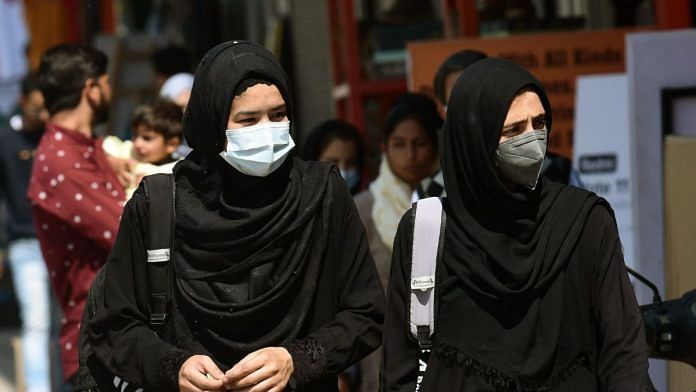
Mahsa Amini, a 22-year-old Kurdish woman from the north-western city of Saqez in Iran, died in hospital on 16 September, after spending three days in a coma.
She was visiting Tehran with her family when she was arrested by the morality police, who accused her of violating the law requiring women to cover their head with a Hijab and their arms and legs with loose clothing. She was then forcibly taken to a re-education centre where she was physically assaulted.
The government refused to acknowledge any connection with her death, saying that she died due to a heart attack or epileptic fit, although her CT scan revealed fractures around her head area, suggesting that she was struck from behind.
The death of this young woman has sparked widespread protests that have now gone viral on social media.
A few months ago, we witnessed another hijab controversy, this time in Karnataka. College students in Udupi were barred from wearing the hijab, resulting in mass upheaval. Petitioners had argued that wearing a hijab was an essential religious practice and barring it was a breach of the freedom of religion guaranteed underneath Article 25 of the Indian constitution.
The Karnataka High Court responded by saying that the wearing of the hijab was a socio-cultural practice, instead of a religious one. Hence, it did not merit constitutional protection.
This decision by the High Court was rather hurried and has been questioned.
Nevertheless, these two situations from two very different parts of the world, which happen to concern the same piece of cloth, give us a glimpse of the complexity in the intersection of gender and religion.
Also read: Leaked documents reveal Iran ordered forces to be ‘merciless’ with protestors, says Amnesty
The Western perception of Islam and the hijab is another riveting element that worsens the already dire situation of Muslim women.
Before the Islamic Revolution of 1979, Iran was a rather ‘progressive’ nation, at least in the West’s view. In 1936, the pro-Western ruler Reza Shah banned the wearing of all veils and headscarves in an effort to ‘modernise’ the country. This changed after the Islamic Revolution.
In an interview conducted by Haleh Esfandari in her book Reconstructed Lives: Women and Iran’s Islamic Revolution one interviewee mentions, “When the veil was finally abolished officially, it was certainly a victory for women but a tragedy, too, because the right to choose was taken away from women, just as it was during the Islamic Republic when the veil was officially reintroduced in 1979.”
This one sentence from that interview perfectly depicts the commonality between the two controversies in Iran and in Karnataka. The right to choose was purloined in both.
Isn’t liberty and progress meaningless if it is not accompanied by this essential freedom?
The interpretations of freedom vary from person to person and even scholar to scholar.
In the paper ‘Veiled Women: Hijab, Religion, and Cultural Practice’, Sara Slininger says: “Concealing a woman’s body is presented as being modest or to protect her from harm: it is not to oppress or exclude women from the community, but for safety.”
Western nations, however, do not always hold this view. The hijab is instead seen as an object perpetuating oppression. Women of the Middle East are often categorised as women who ‘need to be saved’. Their societies are portrayed as barbaric, backwards and uncivilised.
Although these generalisations and stereotypes originated from some level of truth and concern from the West, they are oversimplified and incomplete.
Pulitzer Prize-winning journalists Nicholas D. Kristof and Sheryll Wu Dunn wrote in their book, Half the Sky: “The conservative attitudes in Islamic countries have little to do with the Koran and arise from culture more than religion.”
In their essay ‘Is Islam Misogynistic?’, they noted the classic error in differentiating between causation and correlation by suggesting that in predominantly Muslim Middle Eastern regions, even religious minorities and irreligious people were deeply repressive towards women.
Also read: India’s hijab supporters will lose even if they win SC battle. Because the real war is political
They write, “Americans not only come off as patronizing but also often miss the complexity of gender roles in the Islamic world.”
If we look at the hijab row in Karnataka, it is not associated with the saviour complex of the West. The Hindu majority party in Karnataka has no interest in saving Muslim women. It is simply a blatant attack on religious freedom, which is dictated more by politics rather than the religion itself.
The case of Mahsa Amini is also shaped more by politics than we realise.
It is those in power who lay out the definitions of ‘freedom’ and ‘safety’. It is these influential definitions that decide who we burn and who we worship, and in whose name we protest on the streets.
Although Muslim women fight different fights in different regions, the last thing they wish is for the West to ‘save’ them. Writing pay cheques and funding local NGOs is more than enough from their side. Muslim women are more than capable of fighting their own fight.
One thing to note is that these fights aren’t only black and white, as one would want them to be for the sake of simplicity. There is the fight to wear a hijab in Karnataka, the fight to be free of one in Iran, and lastly, the fight to choose. And that, has always been the hardest fight.
Srina Bose is a student at Springdales School Dhaula Kuan, Delhi. Views are personal.


COMMENTS